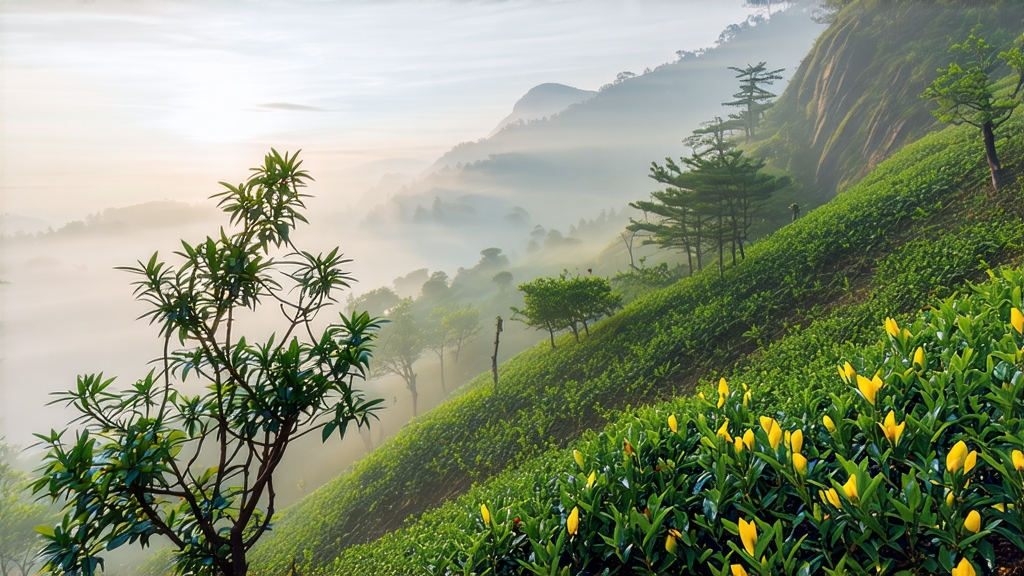
High on Mengding Mountain, where Sichuan’s mist meets the first light of day, a tea once reserved for emperors still unfurls its tiny golden buds. Mengding Huangya—literally “Yellow Bud of Mengding”—is the least-known yet most aristocratic member of China’s yellow-tea family. While green tea commands global shelves and pu-erh fills investment portfolios, Mengding Huangya lingers in quiet groves of ancient camellia sinensis, guarded by Daoist cliffs and 1,200 years of tribute-tea memory. To meet it is to step into a vanished court where Tang-dynasty poets toasted “the dew of Mengding” and Song emperors received it on lacquered trays of jade.
History: From Imperial Tribute to Mountain Secret
The first written record appears in the Chronicles of Mengding compiled during the Tang era (618-907 CE), stating that “the bud of yellow hue, picked before Qingming, is lighter than gold and fragrant than orchid.” By the Song (960-1279) the tea had become one of the thirteen official tribute teas, transported by fast horse along the Jianmen Pass to Kaifeng palace. Ming dynasty (1368-1644) bureaucrats refined the yellowing technique, creating the micro-fermentation that distinguishes yellow from green tea. After the fall of the imperial system the market shifted to bulk greens, and Mengding Huangya retreated up-slope, preserved only by Buddhist monks who valued its meditative sweetness. When Chinese tea scholars re-established the national tea taxonomy in 1958, they found fewer than thirty old trees; today the protected area covers 2,800 hectares, yet annual production remains below 3,000 kg, rarer than silver-needle white tea.
Micro-Terroir: Why the Mountain Makes the Bud
Mengding rises to 1,456 m where the Sichuan basin collides with the Tibetan Plateau. Night temperatures drop 10 °C below daytime, slowing leaf growth and concentrating theanine. Granitic soils rich in potassium and fluorine feed the ancient seed-grown trees whose roots plunge three meters deep. The mountain’s famous “three clouds a day” phenomenon—morning mist, noon valley fog, evening low cloud—acts as a natural shade cloth, increasing chlorophyll and carotenoids that later convert to mellow, chestnut-like aromatics during yellowing. Only buds picked between 20 March and 5 April, when the dew weight exceeds 4 % of fresh leaf weight, qualify for authentic Mengding Huangya.
Pluck Standard: One Bud, No Leaf, 2.5 Centimeters
Experienced pickers climb bamboo ladders at dawn, wearing wrist baskets lined with banana leaf to prevent bruising. The ideal pick is a dormant bud just before the scale leaf separates—what locals call the “fish-hook” stage. One kilogram of finished tea needs 42,000 such buds, roughly six hours of focused plucking by a team of six.
Craft: The Lost Art of Menhuang—Sealed Yellowing
Unlike green tea’s immediate kill-green, Mengding Huangya undergoes a three-stage “sealed yellowing” that can last 72 hours.
- Sha-qing (Kill-green) at 140 °C for 90 seconds in a shallow bronze wok. The goal is to destroy 70 % of leaf enzymes while keeping 30 % for later transformation.
- Men-huang (Wrapping & Resting): the hot buds are immediately wrapped in thick mulberry paper, then in steamed bamboo skin, forming 1.5 kg bundles. These bundles rest inside a cedar box at 28 °C and 75 % humidity for 48 hours. During this anaerobic interval chlorophyll degrades into pheophytin, polyphenols oxidize partially, and a unique microfilm of yeast (Pichia mengdingensis) develops, producing 2-acetyl-pyrroline, the same aroma compound found in basmati rice.
- Low-temperature drying over charcoal embers (60 °C) for three hours, followed by a final “awakening” roast at 45 °C to fix the golden color and chestnut-sweet finish.
The result is a leaf that is yellow-green rather than grassy, with a downy surface that feels like peach fuzz. When rubbed it releases a scent of fresh corn milk and orchid.
Grades & Styles
- Imperial Tip (Te Ji):